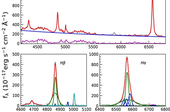 IIA STALIN, C. S
IIA STALIN, C. SSpectropolarimetric view of the gamma-ray emitting NLS1 1H0323 + 342
The gamma-ray emitting narrow-line Seyfert 1 galaxies are a unique class of objects that launch powerful jets from relatively lower-mass black hole systems compared to the Blazars. However, the black hole masses estimated from the total flux spectrum suffer from the projection effect, making the mass measurement highly uncertain. The polarized spectrum provides a unique view of the central engine through scattered light. We performed spectropolarimetric observations of the gamma-ray emitting narrow-line Seyfert 1 galaxy 1H0323 + 342 using SPOL/MMT. The degree of polarization and polarization angle are 0.122 ± 0.040 per cent and 142 ± 9 degrees, while the H α line is polarized at 0.265 ± 0.280 per cent. We decomposed the total flux spectrum and estimated broad H α full width at half maximum of 1015 km s−1. The polarized flux spectrum shows a broadening similar to the total flux spectrum, with a broadening ratio of 1.22. The Monte Carlo radiative transfer code ‘STOKES’ applied to the data provides the best fit for a small viewing angle of 9–24 deg and a small optical depth ratio between the polar and the equatorial scatters. A thick broad-line region with significant scale height can explain a similar broadening of the polarized spectrum compared to the total flux spectrum with a small viewing angle.
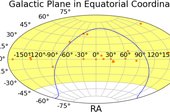 IIA SMITHA SUBRAMANIAN
IIA SMITHA SUBRAMANIANA Partial Near-infrared Guide Star Catalog for Thirty Meter Telescope Operations
At first light, the Thirty Meter Telescope (TMT) near-infrared (NIR) instruments will be fed by a multiconjugate adaptive optics instrument known as the Narrow Field Infrared Adaptive Optics System (NFIRAOS). NFIRAOS will use six laser guide stars to sense atmospheric turbulence in a volume corresponding to a field of view of 2', but natural guide stars (NGSs) will be required to sense tip/tilt and focus. To achieve high sky coverage (50% at the north Galactic pole), the NFIRAOS client instruments use NIR on-instrument wave front sensors that take advantage of the sharpening of the stars by NFIRAOS. A catalog of guide stars with NIR magnitudes as faint as 22 mag in the J band (Vega system), covering the TMT-observable sky, will be a critical resource for the efficient operation of NFIRAOS, and no such catalog currently exists. Hence, it is essential to develop such a catalog by computing the expected NIR magnitudes of stellar sources identified in deep optical sky surveys using their optical magnitudes. This paper discusses the generation of a partial NIR Guide Star Catalog (IRGSC), similar to the final IRGSC for TMT operations. The partial catalog is generated by applying stellar atmospheric models to the optical data of stellar sources from the Panoramic Survey Telescope and Rapid Response System (Pan-STARRS) optical data and then computing their expected NIR magnitudes. We validated the computed NIR magnitudes of the sources in some fields by using the available NIR data for those fields. We identified the remaining challenges of this approach. We outlined the path for producing the final IRGSC using the Pan-STARRS data. We have named the Python code to generate the IRGSC as irgsctool, which generates a list of NGS for a field using optical data from the Pan-STARRS 3pi survey and also a list of NGSs having observed NIR data from the UKIRT Infrared Deep Sky Survey if they are available. irgsctool is available in the public domain on this GitHub public repository (https://github.com/sshah1502/irgsc), while the generated and validated IRGSC for the 20 test fields and additional Pan-STARRS Medium Deep Survey fields can be found on Zenodo.
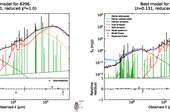 IIA KSHAMA, S. K
IIA KSHAMA, S. KA comparative analysis of the active galactic nucleus and star formation characteristics of broad- and narrow-line Seyfert 1 galaxies
We report here our comparative analysis of the active galactic nucleus (AGN) and star formation (SF) characteristics of a sample of narrow-line Seyfert 1 (NLS1) and broad-line Seyfert 1 (BLS1) galaxies. Our sample consisted of 373 BLS1 and 240 NLS1 galaxies and spanned the redshift 0.02 < z < 0.8. The broad-band spectral energy distribution, constructed using data from the ultra-violet to the far-infrared, was modelled using CIGALE to derive the basic properties of our sample. We searched for differences in stellar mass (M*), star formation rate (SFR), and AGN luminosity (LAGN) in the two populations. We also estimated new radiation-pressure-corrected black hole masses for our sample of BLS1 and NLS1 galaxies. While the virial black hole mass (MBH) of BLS1 galaxies is similar to their radiation-pressure-corrected MBH values, the virial MBH values of NLS1 galaxies are underestimated. We found that NLS1 galaxies have a lower MBH of log (MBH [M⊙]) = 7.45 ± 0.27 and a higher Eddington ratio of log (λEdd) = −0.72 ± 0.22 than BLS1 galaxies, which have log (MBH [M⊙]) and λEdd values of 8.04 ± 0.26 and −1.08 ± 0.24, respectively. The distributions of M*, SFR, and specific star formation (sSFR = SFR/M*) for the two populations are indistinguishable. This analysis is based on an independent approach and contradicts reports in the literature that NLS1 galaxies have a higher SF than BLS1 galaxies. While we found that LAGN increases with M*, LSF flattens at high M* for both BLS1 and NLS1 galaxies. The reason may be that SF is suppressed by AGN feedback at M* higher than ∼1011 M⊙ or that the AGN fuelling mechanism is decoupled from SF. Separating the sample into radio-detected and radio-undetected subsamples, we found no difference in their SF properties suggesting that the effect of AGN jets on SF is negligible.
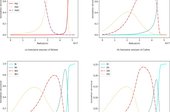 IIA KHUSHBU, K
IIA KHUSHBU, KPhoto-ionization structures of Planetary Nebula IC 2003 with [WR] central star
We present ionization structures of IC 2003, a planetary nebula with [WR] central star, using a 1-D dusty photo-ionization code: ”CLOUDY 17.03”. The photo-ionization model is constrained by archival UV emission line fluxes, medium-resolution optical spectroscopy, IRAS 25 µm flux, absolute Hβ flux, and the mean angular size of the nearly spherical optical nebula. To constrain the carbon abundance and the effect of photo-electric heating in the ionized gas, we used UV emission lines. We considered an amorphous carbon dust grain with MRN and KMH size distributions to address the importance of photo-electric heating in the ionized nebula. We show that KMH grain size distribution with quantum dust heating reproduces the observations quite well. We construct the ionization structures of different elements at their different ionization stages in the nebula. We derive the physical properties of the planetary nebula and its chemical composition, as well as the parameters of its central star. The estimated nebular dust-to-gas mass ratio is 2:37 x 103 , and the enhanced photo-electric heating yielded by small dust grains is 9:4% of the total heating. We considered the H-poor model atmosphere for the central star; the effective temperature of the central star is 177 kK, the specific gravity log(g) is 6, and its luminosity (L*) is 6425 Lʘ. The derived central star parameters plotted on stellar evolutionary tracks correspond to a central star mass of 0.636 Mʘ and to a progenitor mass of 3.26 Mʘ.
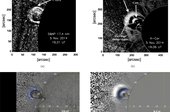 IIA DIPANKAR BANERJEE
IIA DIPANKAR BANERJEEProbing Velocity Dispersion Inside Coronal Mass Ejections: New Insights on Their Initiation
This work studies the kinematics of the leading edge and the core of six coronal mass ejections (CMEs) in the combined field of view of Sun Watcher using Active Pixel System detector and Image Processing (SWAP) on board PRoject for On-Board Autonomy (PROBA-2) and the ground-based K-Cor coronagraph of the Mauna Loa Solar Observatory. We report, for the first time, on the existence of a critical height hc, which marks the onset of velocity dispersion inside the CME. This height for the studied events lies between 1.4 and 1.8 R⊙, in the inner corona. We find the critical heights to be relatively higher for gradual CMEs, as compared to impulsive ones, indicating that the early initiation of these two classes might be different physically. We find several interesting imprints of the velocity dispersion on CME kinematics. The critical height is strongly correlated with the flux-rope minor radius and the mass of the CME. Also, the magnitude of the velocity dispersion shows a reasonable positive correlation with the above two parameters. We believe these results will advance our understanding of CME initiation mechanisms and will help provide improved constraints on CME initiation models.
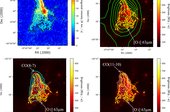 IIA ARCHANA SOAM
IIA ARCHANA SOAMGas Kinematics and Dynamics of Carina Pillars: A Case Study of G287.76-0.87
We study the kinematics of a pillar, namely G287.76-0.87, using three rotational lines of 12CO(5-4), 12CO(8-7), 12CO(11-10), and a fine structure line of [O i] 63 μm in southern Carina observed by SOFIA/GREAT. This pillar is irradiated by the associated massive star cluster Trumpler 16, which includes η Carina. Our analysis shows that the relative velocity of the pillar with respect to this ionization source is small, ∼1 km s−1, and the gas motion in the tail is more turbulent than in the head. We also performed analytical calculations to estimate the gas column density in local thermal equilibrium (LTE) conditions, which yields NCO as (∼0.2–5) × 1017 cm−2. We further constrain the gas's physical properties in non-LTE conditions using RADEX. The non-LTE estimations result in nH2 ≃ 10 5 cm-3 and NCO ≃ 1016 cm−2. We found that the thermal pressure within the G287.76-0.87 pillar is sufficiently high to make it stable for the surrounding hot gas and radiation feedback if the winds are not active. While they are active, stellar winds from the clustered stars sculpt the surrounding molecular cloud into pillars within the giant bubble around η Carina
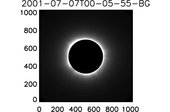 IIA MUTHU PRIYAL
IIA MUTHU PRIYALData processing of visible emission line coronagraph onboard ADITYA-L1
ADITYA-L1 is India's first dedicated mission to observe the Sun and its atmosphere from a halo orbit around L1 point. Visible emission line coronagraph (VELC) is the primary payload on board Aditya-L1 to observe the Sun’s corona. VELC is designed as an internally occulted reflective coronagraph to meet the observational requirements of wide wavelength band and the field of view close to the solar limb (1.05 R Sun ). Images of the solar corona in continuum and spectra in three emission lines 5303 Å [Fe xiv], 7892 Å [Fe xi] and 10747 Å [Fe xiii] obtained with high cadence are to be analyzed using software algorithms automatically. A reasonable part of these observations will be made in a synoptic mode in which the data are processed through a standard pipeline and the resulting products will be made available for public use. The procedure involves the calibration of instrument and detectors, converting the images into the FITS format, correcting the images and spectra for the instrumental effects, and aligning the images (in terms of position angles and image scales) etc. Then, develop image processing algorithms to detect the occurrence of energetic events using continuum images. Also derive physical parameters, such as temperature and velocity structure of solar corona using emission line observations. Here, we describe the calibration of detectors and the development of software algorithms to detect the occurrence of CMEs and analyze the spectroscopic data.
 IIA ARUN SURYA
IIA ARUN SURYAHost-star Properties of Hot, Warm, and Cold Jupiters in the Solar Neighborhood from Gaia Data Release 3: Clues to Formation Pathways
Giant planets exhibit diverse orbital properties, hinting at their distinct formation and dynamic histories. In this paper, using Gaia Data Release 3 (DR3), we investigate if and how the orbital properties of Jupiters are linked to their host star properties, particularly their metallicity and age. We obtain metallicities for main-sequence stars of spectral type F, G, and K, hosting hot, warm, and cold Jupiters with varying eccentricities. We compute the velocity dispersions of the host stars of these three groups using kinematic information from Gaia DR3 and obtain average ages using a velocity dispersion–age relation. We find that the host stars of hot Jupiters are relatively metal rich ([Fe/H] = 0.18 ± 0.13) and young (median age of 3.97 ± 0.51 Gyr) compared to the host stars of cold Jupiters in nearly circular orbits, which are relatively metal poor (0.03 ± 0.18) and older (median age of 6.07 ± 0.79 Gyr). The host stars of cold Jupiters in high-eccentricity orbits, on the other hand, show metallicities similar to those of the hosts of hot Jupiters, but are older, on average (median age of 6.25 ± 0.92 Gyr). The similarity in metallicity between the hosts of hot Jupiters and the hosts of cold Jupiters in high-eccentricity orbits supports high-eccentricity migration as the potential origin of hot Jupiters, with the latter serving as the progenitors of hot Jupiters. However, the average age difference between them suggests that the older hot Jupiters may have been engulfed by their host star over timescales ∼ 6 Gyr. This allows us to estimate the value of stellar tidal quality factor, Q'∗ ∼ 106±1.
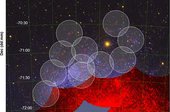 IIA SIPRA HOTA
IIA SIPRA HOTAUVIT Study of the MAgellanic Clouds (U-SMAC) – I. Recent star formation history and kinematics of the Shell region in the north-eastern Small Magellanic Cloud
The interactions between the Magellanic Clouds significantly affect the shape and distribution of the young stellar population, particularly in the periphery of the Small Magellanic Cloud (SMC). We present the first far-UV (FUV) map of the north-east SMC-Shell region using the Ultra Violet Imaging Telescope (UVIT) onboard AstroSat. The detected FUV stars are combined with Gaia Early Data Release 3 data to create a FUV–optical catalogue of ∼14 400 stars. FUV–optical colour-magnitude diagrams are used along with isochrones to estimate the stellar ages. The detected stars are formed in multiple episodes. We identified two episodes of star formation (∼60 and ∼260 Myr ago), where the episode at ∼260 Myr is linked to the recent interaction with the Large Magellanic Cloud (LMC) and the episode at ∼60 Myr is linked to the pericentric passage of the SMC around our Galaxy. The median proper motion (PM) and velocity dispersion are found to be similar to the SMC main body, indicating that this region has not experienced significant tidal effects. The FUV stellar surface density and the dispersion in PM suggest that the extent of the inner SMC in the north-east direction to be around 2.2◦. We detect arm-like and arc-like structures in the FUV stellar density map, and their kinematics appear to be similar to the SMC main body. These extended outer features are the spatial stellar overdensities formed over multiple episodes of star formation, but without apparent kinematic distinction.
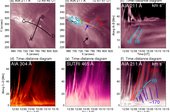 IIA SAMANTA, T
IIA SAMANTA, TNumerous bidirectionally propagating plasma blobs near the reconnection site of a solar eruption
A current sheet is a common structure involved in solar eruptions. However, it is observed in a minority of the events, and the physical properties of its fine structures during a solar eruption are rarely investigated. Here, we report an on-disk observation that displays 108 compact, circular, or elliptic bright structures, presumably plasma blobs, propagating bidirectionally along a flare current sheet during a period of ∼24 min. Using extreme ultraviolet images, we investigated the temporal variation of the blob number around the flare’s peak time. The current sheet connects the flare loops and the erupting filament. The width, duration, projected velocity, temperature, and density of these blobs are ∼1.7 ± 0.5 Mm, ∼79 ± 57 s, ∼191 ± 81 km s−1, ∼106.4 ± 0.1 K, and ∼1010.1 ± 0.3 cm−3, respectively. The reconnection site rises with a velocity of ≤69 km s−1. The observational results suggest that plasmoid instability plays an important role in the energy-release process of solar eruptions.